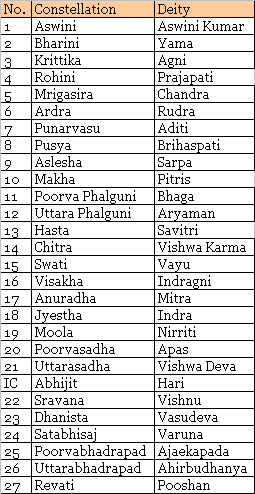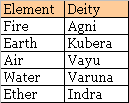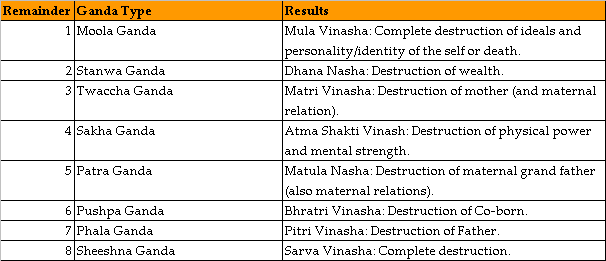Gandanta: The Junction of Fire & Water
INTRODUCTION
The birth during Moon's transit at some specific positions in the zodiac is considered as extremely inauspicious. Gandanta positions are one of those inauspicious positions among others such as usna ghatikas, visha ghatikas etc. The person born under gandanta suffers numerous miseries in life and based on the exact nature of the gandandta even the parents and other relations can be severly affected. To alleviate the troubles from the Gandanta birth, it is advised to do shanti puja for birth during this time.
Gandanta is comprised of two terms Ganda and Anta, where Ganda means "a node" and anta means "the end". The whole zodiac is visioned to have three nodes at zero degree Aries, Leo and Sagittarius, which are also called the brahma randhra (eye of Brahma, the creator) or Vishnu Nabhi (the navel of Vishnu, showing the beginning of creation). To understand why Gandanta is known to be inauspicious, we need to understand the creation process. The creation process is cyclical, which starts with the emergence of creation impetus and ends with dissolution of the whole creation to nothing-ness. This cycle can be mapped to the four elements of nature in the oder of Fire, Earth, Air and Water and the whole process of creation and dissolution happen under the ambit of the Ethery element. In the zodiac the whole creation process repeats thrice from the beginning of Aries, Leo and Sagittarius, the three fiery signs. While mapping the creation process with the nakshatra scheme of zodiac reckoning, the three cycles start from Aswini, Magha and Moola. However, before the creation starts the end of the watery signs namly, Cancer, Scorpio and Pisces, shows the dissolution of the creation. Thus the beginning of the mentioned three fiery signs shows transition from the dissolution phase to creation phase and hence they represent as three nodes in the zodiac, each starting its own process of creation. Hence the person born near to these nodes are caught in the process of transition from destruction of old creation and start of new creation and hence suffer the burnt of it. Like the start of creation is shown by the beginning of Aswini, Magha and Moola, the end of destruction is represented by Ashlesha, Jyeshtha and Revati, which falls in the ending part of Cancer, Scorpio and Pisces. Thus the gandanta nakshatras are these six nakshatras with the 4th pada of last nakstras of watery signs and 1st pada of first nakstras in the fiery signs. They are the 4th pada of Revati (Pisces), Ashlesha (Cancer), Jyestha (Scorpio) and the 1st pada of Ashwini (Aries), Magha (Leo) and Moola (Sagittarius).
Thus the gandanta happens whenever there is a transition from watery element to fiery element. Anyone born during such transition has to suffer the trouble due to this transition and suitable remedy is required to alleviate the troubles.
NAKSHATRA GANDANTA
Moon’s motion in one Nakshatra is supposed to be 60 ghatikas and hence the duration of the Nakshatra which is affected by the Gandanta dosa is measured in terms of the Ghatikas. For the first constellations of fiery signs, the first three Ghatika and the last five Ghatikas before the end of the last constellation of watery signs are the precise duration of Gandanta. Since the arc duration of one Nakshatra is 13d 20m or 800 min, which is equivalent to 60 ghatikas of time, 3 ghatikas would be equivalent to 40 arc mins and 5 ghatikas would be equal to 66.67 arc mins. Thus while reckoning the gandanta in terms of the arc of the zodiac, we must take last 66.67 arc min of the last Nakshatra of the watery signs and the first 40 arc mins of
Classification of Gandanta
Classification 1:
§ If birth is in the daytime, it is called Pitri (father) Gandanta while a night birth during Gandanta is called Matri (mother) Gandanta.
Classification 2:
§ Birth in Revati (Pisces) – Aswini (Aries) junction is called Swa (self) -Gandanta
§ Birth in Aslesha (Cancer) – Magha (Leo) junction is called Matri (mother) Gandanta
§ Birth in Jyestha (Scorpio) – Moola (Sagittarius) junction is called Pitri (father) Gandanta.
Abhukta Gandanta
Narada Muni has stated that of these six constellations, the “Abhukta Moola Gandanta” comprises the last two Ghatika of Jyestha and first two Ghatika of Moola constellation. He adds that such a child should be abandoned (or given away) or any form of hope from him should not be made. Since this is the pitri gandanta, if the child survives, father should not see his face for 8 years after birth. Other authorities indicate 27 days for this abstraction of father from seeing the face of the child, which seems more practical in today’s context. Thereafter suitable remedial measures should be performed.
Moola-Nivasa (Residence of Moola)
Classification of Gandanta
Classification 1:
§ If birth is in the daytime, it is called Pitri (father) Gandanta while a night birth during Gandanta is called Matri (mother) Gandanta.
Classification 2:
§ Birth in Revati (Pisces) – Aswini (Aries) junction is called Swa (self) -Gandanta
§ Birth in Aslesha (Cancer) – Magha (Leo) junction is called Matri (mother) Gandanta
§ Birth in Jyestha (Scorpio) – Moola (Sagittarius) junction is called Pitri (father) Gandanta.
Abhukta Gandanta
Narada Muni has stated that of these six constellations, the “Abhukta Moola Gandanta” comprises the last two Ghatika of Jyestha and first two Ghatika of Moola constellation. He adds that such a child should be abandoned (or given away) or any form of hope from him should not be made. Since this is the pitri gandanta, if the child survives, father should not see his face for 8 years after birth. Other authorities indicate 27 days for this abstraction of father from seeing the face of the child, which seems more practical in today’s context. Thereafter suitable remedial measures should be performed.
Moola-Nivasa (Residence of Moola)
1. In the Vedic months of Margasirsa, Phalgun, Vaisakha and Jyestha the residence of Moola is in “Patala Loka” (the hell).
2. In Sravana, Kartika, Chaitra and Pausa the residence of Moola is in Martya Loka (the realm of Dead).
3. In the four Vedic months of Ashada, Aswina, Bhadra and Magha, the residence of Moola is in Swarga Loka (the Heavens).
If birth is in Gandanta and the residence of Moola is in the realm of the dead (Martya Loka) then great evil is indicated. The evil is lesser for the other Loka. Movable, Fixed and Dual signs as the (Lagna) are said to give Moola residence of Swarga, Patala and Martya loka respectively. Thus, if someone is born with dual sign as Lagna which Moon in the last quarter of Jyestha or first quarter of Moola, then great evil falls on the native.
Ganda Phala: (Results of birth in Gandanta).
Lagna being the governor of intelligence and the Moon, the governor of physical body, Lagna Gandanta results in the loss of intelligence while Rasi Gandanta results in premature death or loss of longevity.
Remedies (from Vedic Remedies in Astrology by Pt. Rath)
The remedy lies in worshipping the Lord of the Lagna/ Moon constellation depending on whether it is Lagna or Rasi gandanta. This deity becomes the “Devata” who can break the weakness due to Gandanta. Since the affliction comes from an adjoining sign, the lord of the nature of the sign becomes the “Adhi-Devata” and the lord of the afflicting constellation becomes the “Pratyadhi-Devata”.
For example, let us determine the deities for Jyestha Gandanta. The Lord of the Jyestha constellation is Indra. So, Indra is the Devata or Chief deity. Jyestha is in Scorpio and the junction affliction comes from the sign Sagittarius having the Moola constellation. Sagittarius is a fiery sign and the God of fire Agni is the Adhi-Devata. Moola is the afflicting constellation and the Lord of this constellation is Rakshas who is the Pratyadhi-Devata.
Nakshatra Deities

Abhijit Nakshatra: Abhijit nakshatra is called the intercalary(IC) nakshatra as it appear as a small (smaller duration as compared to normal duration of nakshatra 13d 20m) nakshatra between Uttarashadha and Sravana. The duration of Uttarashadha is divided into four parts and the first three padas are assigned to Uttarashadha, which makes the duration of Uttarashadha to be 10deg with each pada to be 2d 30m. The remaining one pada of Uttarashadha is assigned to Abhijit, the intercalary nakshatra. Similarly beginning 1/15th part of Sravana is given to Abhijit, making its total length to be 253.33 min, i.e., 4d 13m 20s. The remaining 14/15th part of Sravana is assigned to the four padas of Sravana, making the total duration of Sravana to be 12d 26m 40s
Element Detities

The ritual is normally performed in the Eastern or Northern part of the house depending on whether the Gandanta is in a fiery sign (East) or watery sign (North). The Kalasha (water pot) containing Panchagavya, Shastaushadhi and Ganga water is installed. The idol of the Devata is installed on another earthen pot adjoining the Kalasha or a gold coin can be used to represent the deity. Similarly, the Adhi-devata and Pratyadhidevata are also installed and worshipped (For more details refer to BPHS). This is followed by a Yagya (Fire sacrifice) & Abhishek (Ritual bathing with Mritunjaya Mantra). The water from the two Kalash whould be poured on the head of the parents and the child. Donations, Dakshina and breaking of fast ends the ritual. Rudrabhishek as well as ceremonial bathing of the afflicted persons is necessary. For (1) day Ganda dosha father and child (2) Night birth Ganda dosha Mother & child and (3) Sandhya (Sunrise/ sunset) born Ganda dosha both father & mother and child are protected with Abhishek using four vessels of water etc and Sahasraksha Mantra.
People who cannot afford these elaborate rituals should recite the Mahamritunjaya Mantra eight thousand times within 40 days starting from the 12th day from the birth of the child. It maybe noted that remedial measures cannot be performed for 11 days following birth.
Other results
Besides what has already been stated, there are other methods of determining the results of gandanta. The number of the birth asterism (Janma Nakshtra) is multiplied by three (3). The numbers of birth tithi (as recknoed from Sukla Paksha prati pada) and the day of birth (as reckoned from Sunday) are added and the sum is divided by eight (8). The remainder indicates the Ganda Dosh (Error/Evil).


Comments
Many thanks in advance.
Nikos
anyway, i have janma nakshatra gandantha in the last pada of cancer and i am wondering if i can still do the abishek, etc..remedies even though it is listed to do at the time of birth.
respectfully, amrita